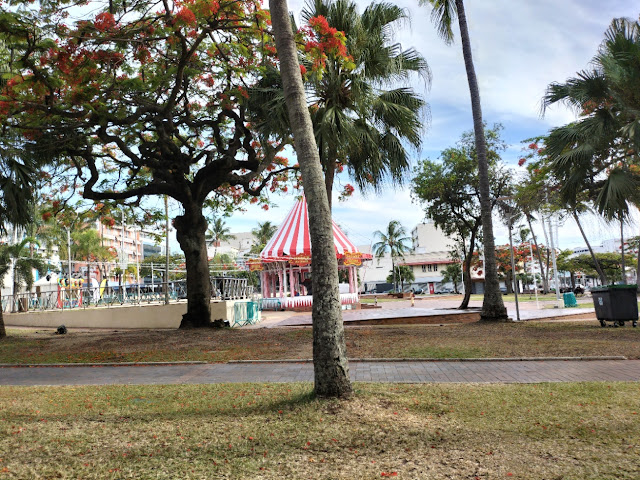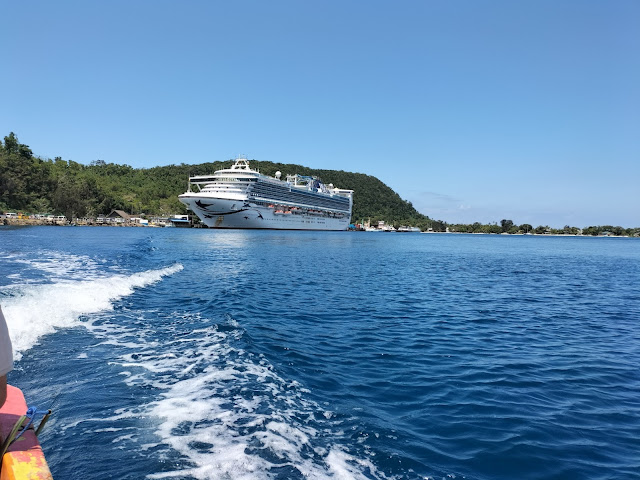We began our journey by celebrating Penny's birthday with a delicious Italian meal at Gusto de Gianni Restaurant on the Portside Wharf at Hamilton, Brisbane.
The next day we boarded the P&O Pacific Encounter, at the Brisbane International Cruise Terminal, bound for the South Pacific. For the past few days we had been, no doubt like thousands of others, glued to the latest on Cyclone Jasper and where and when he might appear. However, our cruise itinerary was unaltered and we embarked, quite prepared that it might change at some stage.
Passing Queensland's Glasshouse Mountains
Passing Caloundra
We sailed out to the Coral Sea, and our first port of call was New Caledonia, a French territory. We cruised into the capital Noumea and took a shore excursion for 1.5 hours on the local Tchou Tchou Train. We saw much of the city and surrounds whilst our local guide, who spoke perfect English, relayed the history of the country including the infrastructure work completed by the Americans during and following WW2.
She told us that the main island is shaped like a French baguette, and that there are four other smaller islands to the east known as the Loyalty Islands. And after the Great Barrier Reef, the reef which encircles the entire main island is the longest in the world. The main industry is the mining and export of nickel: New Caledonia contains 10% of the world's supply.
Nickel production
One of many tiny islands offshore, which the locals visit on weekends. This one is a cocktail bar!
Tchou Tchou Train
Unfortunately, the local craft markets don't operate on Mondays and as well, most of the shops were closed, so we made our way back to the ship for a leisurely afternoon.
The next morning, we arrived at one of the Loyalty Islands, Lifou. The ship was too big to dock, so we were tendered across some of the bluest and clearest water we have ever seen. Upon reaching the wharf we discovered that Lifou was reminiscent of one of Penny's favourite 60s TV shows, Gilligan's Island!
On Lifou there was no commerce apart from locals selling mostly shell and timber souvenirs, along with plates of bananas, watermelons and lychees, under big open barns. Coconut palms were everywhere, and the ominous crack of machetes on coconuts followed us wherever we went. Everything revolved around the water, as hundreds of our fellow passengers dived, snorkelled and swam, or lapped up the sun on the pristine white sand.
It was certainly an 'untouched' paradise, and as we searched for the wreck of the S S Minnow, we half expected to see the Professor or Mary-Ann pass by...
The wharf at Lifou
The main settlement of Lifou
Our third and final port of call was Port Vila, the capital of Vanuatu. For our previous ports, the ship advised we needed to purchase a ticket for a shuttle for the first, and a tender for the second. But for this port we were told the ship would dock right in town and we could walk from there.
That was true except that the ship actually docked 3kms from town and as it was close to 30C with high humidity, we headed for the information centre on the dock. There we grabbed a map of town and were told we could take a cab ($20 each way) or a water taxi ($5 per person each way) or walk. Since the cabs are non-air-conditioned, we opted for a water taxi which wasn't what we expected but was nevertheless a great way to travel.
They squeezed 14 of us into the boat, three abreast plus the driver. It was a challenge to get into the boat as the driver simply pulled up to a pier and it was every person for themself. One passenger gave Penny a hand in, and then Penny helped Jim in. It didn't help that underfoot was very wet - the boat sat down fairly close to the water, and it appeared to be leaking near Jim's left foot.
However, we thoroughly enjoyed the 10-minute ride to town with a cool breeze in our faces, and picture perfect scenery.
Assumed this was the town's rubbish tip?
One of the country's casinos
One of the resorts - this one is on an island opposite the town
Our 'water taxi' once we disembarked
Penny had visited Port Vila back in 1983, and remembered dusty roads, ramshackle premises and craft markets. Now the roads are sealed.
We wandered through a couple of huge craft markets selling scarves and dresses, shells of all shapes and sizes, hand-made jewellery (mostly shells), miniature wooden outriggers and some wonderful timber carvings. But the ship had warned us that if we bought anything in timber, we would need to declare it once we arrived back in Brisbane. It just wasn't worth the risk.
Strolling through an interesting vegetable market, we came to the narrow main road which was full of souvenir shops and supermarkets. We also saw familiar businesses like the ANZ Bank and Prouds jewellers as well as a couple of duty-free stores, an enormous local eating house and lots of traffic.
One of several high-rise buildings, this hotel/casino had seen better days
Back to the water taxi for our return ride. Penny sat next to a nice woman from the Gold Coast who, with her husband, had been to Port Vila many times. She told Penny that on one of their many water taxi trips, her husband had grabbed the timber seat (they all just sit in place), threw it and himself into the water, grabbed a rope from the boat and water-skied all the way to town. Apparently, the driver thought it was a hoot and yelled at his passing fellow drivers to watch! We don't know how deep the water was, but we do know that there was no safety equipment of any kind on board...
Vanuatu comprises 83 islands and has been around a very long time. Archaeological evidence in the way of cave drawings and ancient burial sites indicates that by 1300BC the northern islands had been settled by the Lapita peoples who came from Melanesia to the west. It was in 1774 that Captain James Cook named the islands The New Hebrides and this remained the name until independence in 1980.
The main industry in Vanuatu is agriculture, with 80% of the population involved. Beef cattle is also an important industry, as is tourism. That afternoon we sat on our balcony as the ship departed Port Vila. The views were spectacular as we sailed through the heads and out to sea.
We had of course found a lounge-bar on the ship that we loved and headed there in the evenings for a drink before dinner. It is called the Blue Room and most nights it hosted entertainment including a wonderful four-piece show band who played jazz and other instrumentals, and a duo, female singer with male guitarist, who performed wonderful well-known songs from the 60s to the present.
Dinner was included in one of three restaurants, the Waterfront Restaurant, Angelo's (Italian) and Dragon Lady (Asian) as well as a buffet called The Pantry. There were also two specialty restaurants, Luke's Bar and Grill and the Trattoria, so there were plenty of food options! Just as well the cruise was only for seven days...
The Dragon Lady - the restaurant, that is!
The photos tell the tale - the weather was amazing, there was no sign of a cyclone, and the seas were smooth.
And as we said farewell to the South Pacific, Petrels off the port side of the ship waved goodbye!




































